It was a time of peak naval aviation of sorts, with President Reagan’s military buildup having drastically expanded the Navy’s fleet, the movie Top Gun having become a pop culture sensation, and the Soviet Union sputtering towards its eventual collapse. To call it a colorful time in military and world history would be a vast understatement. It was here, during the twilight of the Cold War, that Kevin Noonan found himself hunting submarines from the cabin of a carrier-based S-3 Viking.
We followed Noonan through the trials and tribulations of training and learning the shadowy art of chasing submarines from the sky. Then went along with him on his first cruise aboard an aircraft carrier where we got a full understanding of how he plied his deadly sub-hunting trade. Now, in this the third part of our four-part exclusive series, we strap-in beside Kevin to see not only him, but also his beloved mount, the S-3 Viking, mature into wiser and more potent weapons of war.
Back To The Boat
After a major deployment, a carrier and its air wing tended to get a solid month of rest—rest being a relative term. At the squadron, during the first days at home, our sister squadrons would stand our hangar and Squadron Duty Officer (SDO) watches. But even for the first month, we operated with a skeleton crew with many of the squadron members on leave and a good portion more being transferred to their next duty station. Some, after a Mediterranean (Med) cruise, were more than happy to get out of the Navy if their enlistment was up.
Those fools!
We did very little flying during the first month back home at NAS Cecil Field. In fact, a returning squadron sometimes gave up their best birds to the squadron that was in line to deploy next. Other aircraft, particularly the notoriously broken ‘hangar queens,’ might be sent for major repair at a high-level maintenance station. My impression of this time around was that I had somehow rejoined the Naval Reserves! It was so quiet, but neither squadron nor aircraft carrier rests for long.
Oh, wait, we no longer had an aircraft carrier, at least for the time being.

It was one hell of an interesting culture shock when we arrived aboard the then-latest Nimitz class aircraft carrier, the USS Theodore Roosevelt (CVN-71) in February of 1988. She was to be Air Wing Eight’s (CAG-8) new home.
One might think that one Nimitz class carrier is the same as any other Nimitz class carrier. They, however, would be wrong. Granted, the various decks remain the same and to the untrained eye, the ship’s outward appearance seems the same, but the personality of the ship, her crew, and the ship’s ‘soul’ are entirely different.
My fellow enlisted Naval Aircrewmen (AWs) and I of Sea Control Squadron 24 (VS-24) “Scouts” were excited to be aboard a brand-new boat. That is, until we discovered we did not have a special aircrew berthing or a space for our aircrew shop.
Misery quickly set in.
No one from CAG-8 had bothered to think about the needs of VS-24 other than the acquisition of Ready Room Four that occupied the same deck and spaces we had aboard Nimitz, as well as the maintenance shops required to allow our squadron to function. If memory serves, they failed to provide us with a place for our Personnel Department as well. As a result, that misery quickly transformed into being pissed off.

For our aircrew shop, we ended up getting a paint storage space…that had no air conditioning and no heat. We’d be in the Caribbean in a few days and above the Arctic Circle in a few months. Worse still, we ended up sharing sleeping spaces on the O-3 level that berthed over a hundred other sailors in the stern or in the bow. We moved back and forth between these two locales several times over the next two years.
The space in the bow was the most difficult to adjust too. That berthing lay just beneath the bow catapults. Every time an aircraft would be launched, we’d be entertained with resonating sound of the shuttle running the length of catapult track ending with a powerful ‘THUMP!’ as it stopped at the water brake.
If we slept, it was a fitful, angry sleep.
It may sound like I’m whining, but aircrew sleeping habits were dictated by NATOPS (Naval Air Training and Operating Procedures Standardization) and we actually needed a small, isolated space like we had on Nimitz that allowed us to sleep around the clock since we flew around that clock. Granted, we couldn’t avoid the bow catapult sounds and the Air Wing’s ‘Officer Country’ sleeping area was also in the bow on the 0-3 level, so us enlisted guys weren’t subject to that issue alone. What we could have avoided was the noise made by a whole bunch of sailors coming and going throughout the day and night slamming stand-up and coffin lockers, laughing, and doing the things tired sailors do.
Yes, this is me…still whining some 30 years later!
Otherwise, “TR” was a really great ship. Over the months ahead we adjusted to the black shoe crew (those that ran the ship), and they to us, and learned to commune with the spirit of this brand new, mighty aircraft carrier.
The culture shocks kept coming, however. On the flight deck, an airplane that looked suspiciously like a lawn dart had replaced that lovable, combat-proven Short Little Ugly Fucker, or SLUF, that was also known as the A-7 Corsair II. No longer did we share the flight deck with the Marauders of VA-82 and Sidewinders of VA-86.
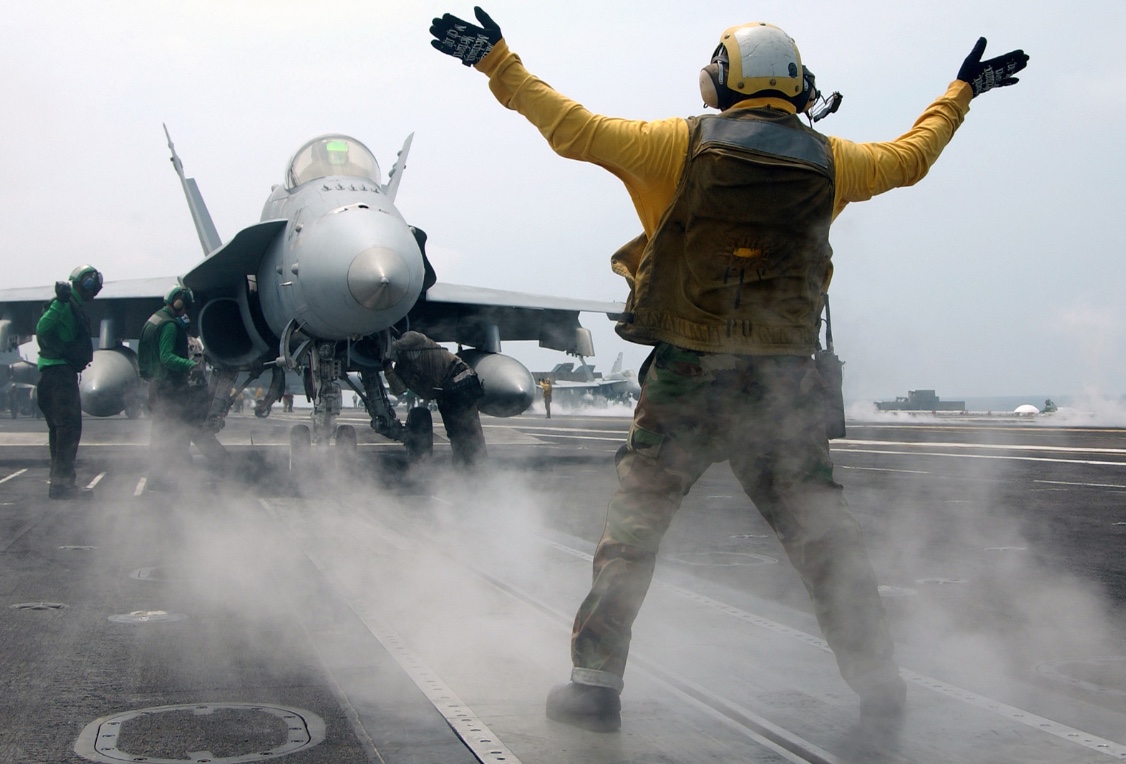
After a week or so of carrier qualifications for all the air wing aircraft, including the hybrid fighter-attack squadrons VFA-15 ‘Valions’ and VFA-87 ‘Golden Warriors’ and their shiny, new, low-viz grey F/A-18 Hornets, we headed to the Gitmo Op Area (just off Guantanamo Bay, Cuba) for a shakedown cruise. Although it took time, ship and air wing began to find a mutual rhythm.
Oh, here’s something you all may not have considered: every time an Atlantic Fleet aircraft carrier pulled out of Norfolk or Mayport requiring its Air Wing to embark, the poor VAQ bastards (electronic attack squadrons) had to fly their EA-6B Prowlers and their squadron all the way across the length of the United States and meet their particular ship. And us Florida-based squadrons bitched and moaned…constantly…about our comparatively very short trek off our coast to the ship.
Since I had joined the Nimitz back in ’86, a month prior to her last Med deployment from the East Coast, I missed all the fun of the work-up cycle, which found a carrier and her squadrons going to sea very often. Sometimes, it lasted just a couple of weeks while at other times we’d be at sea for a month or two. The process of going back and forth made going to the boat a genuine pain-in-the-ass. Looking back, of course, I’d gladly haul cruise boxes up and down narrow ladders and through endless numbers of knee-knockers just for the chance to serve aboard today!
Sometimes, the ship pulled out of Norfolk without us. Consider this brief, interesting at sea period described in the Roosevelt’s official Command History:
Standardization and deceleration trials were conducted with David W. Taylor Naval Ship Research and Development Center observers at HECTOR RANGE on 23 and 24 April. Resulting data determined maximum speed for CVN-71 and filled in tactical data for NIMITZ class carriers.
Now that had to be fun!
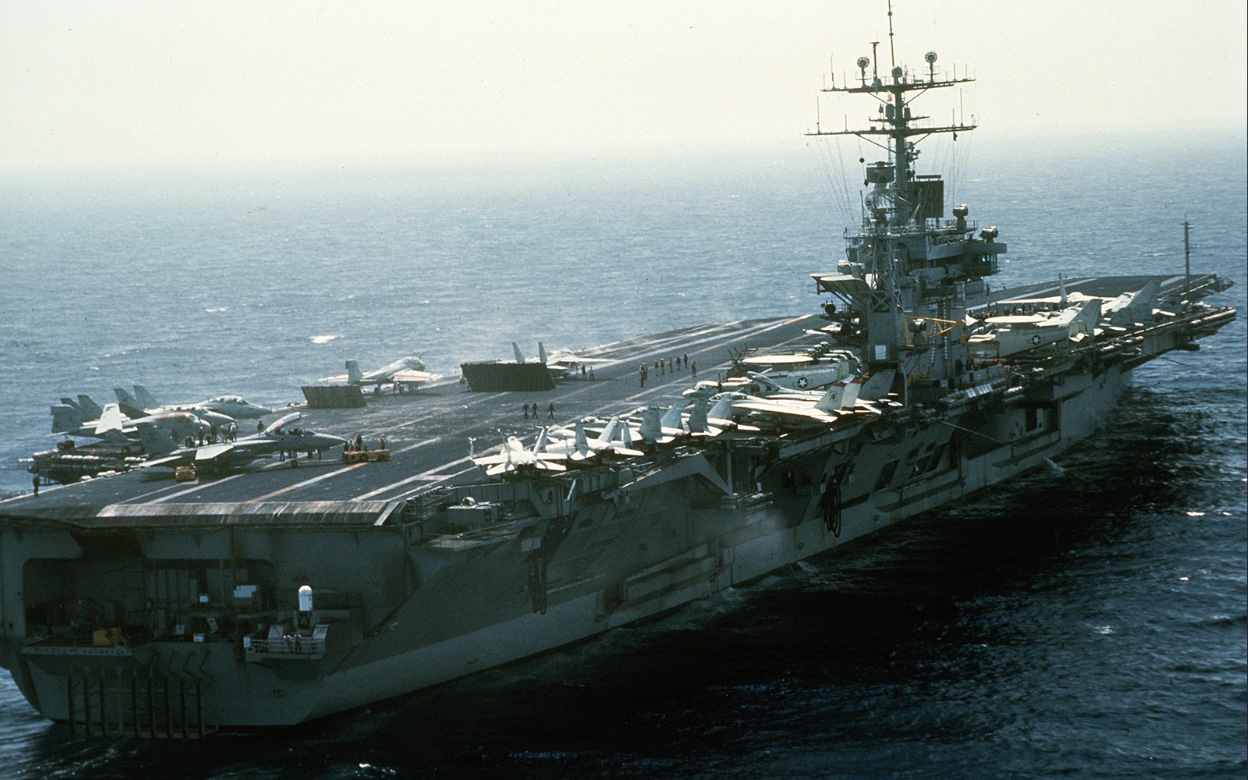
As is the nature of an aircraft carrier’s flight deck, tragedy is just one distraction away, no matter how well the crew gels. On the morning of March 13th, we happily welcomed the arrival of a C-2 Greyhound COD. After she unloaded her mail and supplies and reloaded passengers who were leaving the boat, the E-2 squadron maintenance personnel started her up for taxiing to the cat where she would launch with the next cycle.
I was in our ready room and for some reason my eyes were glued to the PLAT TV screen, which was filled with the COD getting in position for launch. Then, to my horror, a young VAW-124 plane captain…mesmerized…walked into one of the C-2’s spinning propellers.
I just couldn’t understand what I just saw.
I do not remember much more of that day except the haunting sound of the call for a FOD (foreign object debris) walk-down on the flight deck after TR lost her first crew member.
Despite our tragic loss, we successfully completed a period of operations that had us learning how to work as an air wing again. The Roosevelt then sailed north out of the Caribbean and dropped anchor off of Fort Lauderdale, Florida on March 31st. Some of the aircraft and most of the CAG-8 personnel disembarked to make room for an oddly-timed Tiger Cruise that saw over 1,500 dependents join the Navy’s newest aircraft carrier.

At the end of the following month, we once again joined the TR for ops off of Virginia, Jacksonville, and in the Caribbean to accommodate the Reactor Department’s major readiness inspection known as the ORSE (or Operational Reactor Safeguards Examination). This at-sea period lasted from the 23rd of May to the 28th of June.
Once again, tragedy struck the flight deck. This time it was a member of my own squadron and a friend. William Berry, a young airman, was working to become an Aviation Electrician (AE), if memory serves. He was one of the most promising, gentle, professional, and kind individuals I had ever had the pleasure of meeting.
Despite the admonishment to keep your head on a swivel on the flight deck to see what is going on all around you at all times, you can’t account for everything, including not seeing a Tomcat turning its two powerful engines toward you. Berry was lifted off his feet by an F-14 and blown over the side of the flight deck, falling 90 feet into the ocean, the surface of which acts as essentially concrete from such a high fall.
Some said they witnessed him struggling, while others stated he didn’t move after impact. As the ship mustered for the man overboard, the plane guard helicopter searched and searched for him. Sadly, everyone quickly lost sight of him.
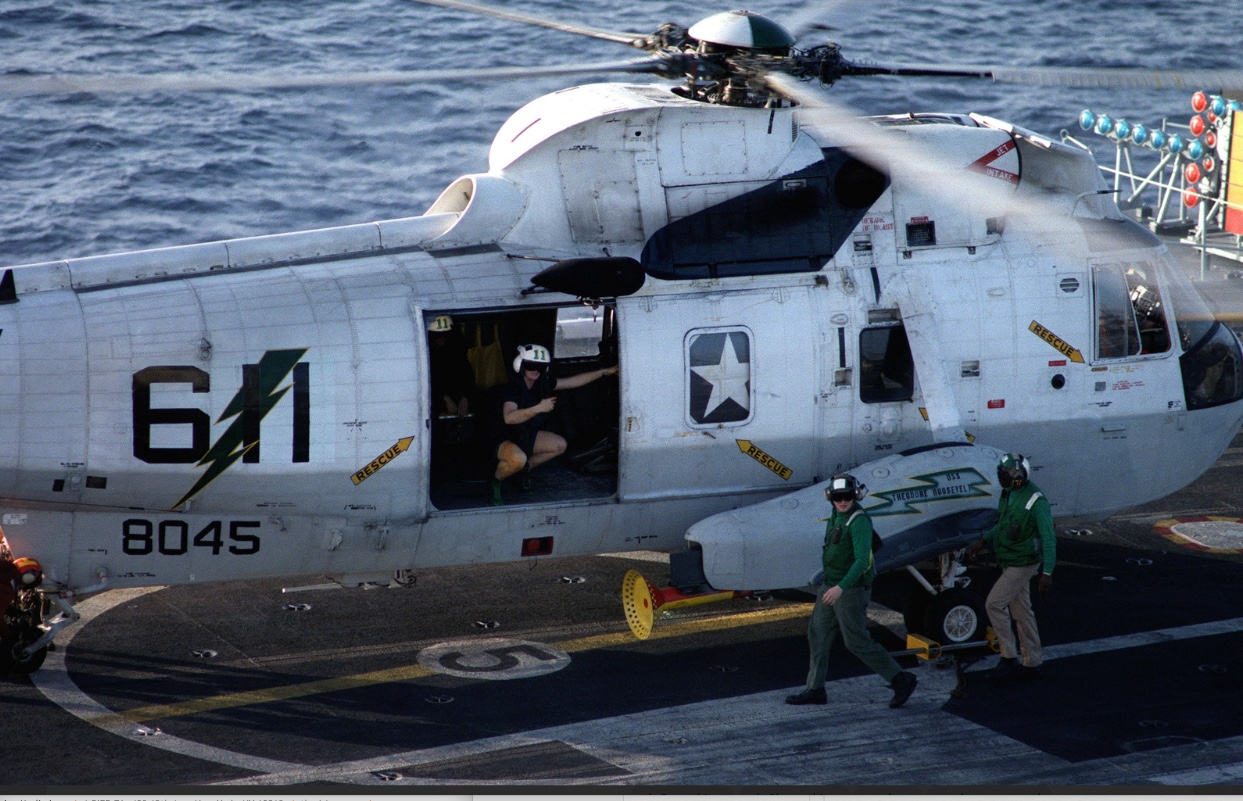
Once the ship-wide muster was complete—confirming he was the only soul missing—I went out onto the starboard aft sponson in what daylight remained…and stood there…willing my eyes to see him… just over there…
His body was never recovered.
It is a genuinely precious thing, when serving in the military and watching people die, to be forced to face the full weight of what it means to be human…particularly at that young age when you are certain you are not only infallible and indestructible, but also eternal.
From Russia With Love
An interesting at-sea period took place without us having to embark on the 7th of July, 1988. Again, the ship’s official Command History describes what was a truly historic event:
The top Soviet military officer, First Minister of Defense and Marshal of the Soviet Union Sergei F. Akhromeyev, and a dozen top-ranking Soviet military officers embarked. The Marshal’s visit was the first time a Soviet military leader had been aboard one of America’s sophisticated nuclear-powered aircraft carriers. Guests of the Chairman, Joint Chiefs of Staff, Admiral William J. Crowe, the Soviets were given a tour of TR, from galley to the bridge. Ship operations were explained by TR crew members. On the flight deck they observed aircraft being launched and recovered and Carrier Air Wing EIGHT’S air power demonstration.

A month later, President Reagan was giving a speech for the 70th Annual National Convention of the American Legion and described what took place aboard TR during the Soviet visit. His words still give me the chills:
“We took Marshal Akhromeyev to visit our newest supercarrier, USS Theodore Roosevelt. We thought it would be a valuable education for him. And so he saw that magnificent ship go through its paces. He watched our superb aircraft perform. All in all, he spent a day on one of the technological wonders of the world, a floating airfield his Navy had nothing to equal; and yet, you know what he said he was most impressed with when he was through with the visit? Our enlisted men and women. I was told that he couldn’t get over the fact that we had them doing work that the Soviets would reserve exclusively for officers, in many cases, very superior officers. And he couldn’t believe that our enlisted people were so self-assured in speaking up when asked a question, so articulate in giving their replies, and so ready to add their opinions.”
It was a great time to be an American sailor and a great, great time to be an AW.
Then, on August 25th, the USS Theodore Roosevelt joined up with her full battlegroup for the first time and set sail toward the North Atlantic on one of the most realistic exercises I had ever been on or would be a part of. Teamwork ’88 most closely resembled what we would do in a war with the Soviet Union.
War In The Fjords
As we prepared to engage in a wartime penetration of the Greenland-Iceland-United Kingdom (GIUK) gap on our way to the aircraft carrier bastions that were, and still are, the Norwegian fjords, we were joined by over 200 allied warships and auxiliaries and over 500 aircraft of all types. Some of those ships would form an amphibious strike force that would conduct a landing on the northern part of Norway on the 16th of September to practice repelling an anticipated Soviet invasion. German and Dutch warships would form a Task Group that would escort a resupply convoy sailing from England to Central Norway. From there, a Norwegian Task group would takeover escort duty and resupply allied warships and bases at Bodo and Narvik.
The United States’ first supercarrier, the USS Forrestal (CV-59) would join the nation’s latest supercarrier in a simulated battle. A third flat top, the U.K. Royal Navy’s HMS Illustrious (R06), would meet us off Iceland as we ran the GIUK gauntlet.
The Brits would act as overall anti-submarine warfare (ASW) commanders for both carrier battle groups (CVBG) and the amphibious group.
To contrast a Cold War CVBG with today’s Carrier Strike Group (CSG), allow me to list my carrier’s battlegroup elements:
USS South Carolina (CGN-37) our primary carrier escort
USS Leyte Gulf (CG-55) air warfare commander and towed array ship
USS Mahan (DDG-42)
USS William V. Pratt (DDG-44)
USS Moosbrugger (DD-980) our most excellent towed array ship
USS Comte De Grasse (DD-974)
USS Charles F. Adams (DDG-2)
USS Conyngham (DDG-17)
USS Moinester (FF-1097) our towed array frigate.
USS Detroit (AOE-4) a “fast combat support ship” that was our one-stop-shop for fuel, weapons, snacks, and cigarettes.
We also had two nuclear fast attack submarines (SSNs) escorting us: the USS Jack (SSN-605), an old Permit class boat that was still fighting strong, and possibly the very unique and super quiet USS Narwhal (SSN-671). Overall, more than 10 submarines would be participating in the exercise.
Again, this was just my CVBG! The Forrestal had a similar composition of warships escorting her, as well.
As we made our way up the North American east coast with the amphibious strike group, we were joined by a Canadian Task Force off of Halifax, Nova Scotia. Then, just south of Iceland, we were further reinforced by the primary NATO ASW Strike Force under command of the British on board the “Harrier-carrier” HMS Illustrious (R06).
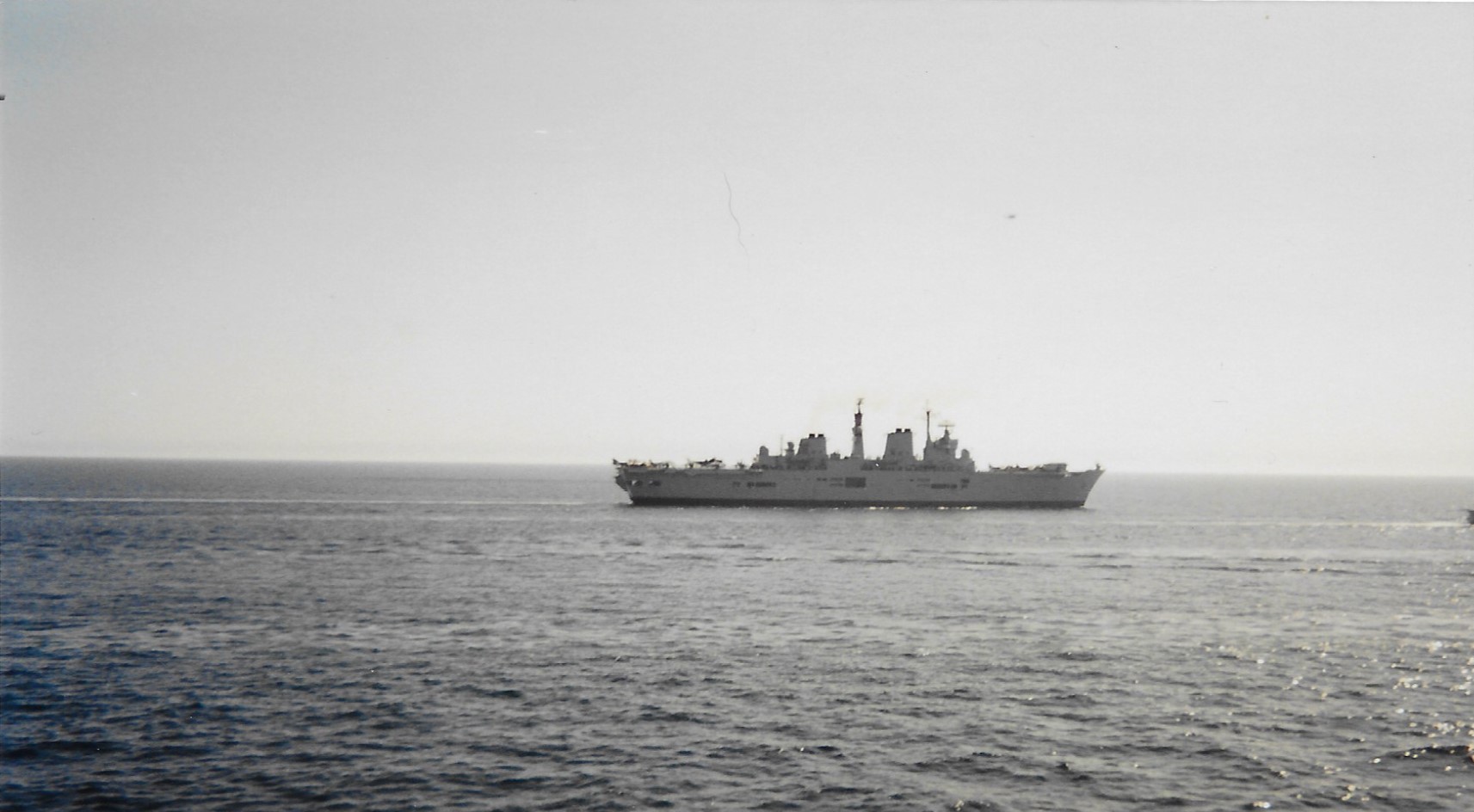
Over the next few days, we fought an opposed penetration of the GIUK Gap, simulating NATO’s failure to anticipate Soviet preparation for a war. Ideally, our forces would already be in the Norwegian fjords before the deployment of the Red Banner Northern and Baltic Fleets….ideally.
With the addition of some of our escorts with towed sonar arrays and the full Canadian task force, the NATO ASW Strike Force set about clearing the waters between Greenland, Iceland, the Faroe and Shetland Islands. The Ticonderoga class cruisers worked with our E-2s and Tomcats to defend against the various Soviet Naval Aviation threats that opposed us including:
Tu-16 Badgers (primarily the G and J variants) simulated by various aircraft including EP-3s, EA-3Bs, EA-6As, NKC-135s, British Canberras, and the unique EC-24 – the DC-8 the USN modified for electronic countermeasure (ECM) training.
Tu-95 Bears (primarily the D and F variants) simulated by EP-3s.
Su-24 Fencers simulated by Norwegian F-16s and British Tornados and Buccaneers.
Various anti-ship missiles primarily those fired by Badgers, Bears, from Nanuchka class missile boats, and from nuclear-guided missile submarines (SSGNs)—Charlie IIs and the sole Papa class boat, during wartime. These missiles were simulated by Buccaneers and Canberras.
It was quite the battle just to penetrate this famous group of choke points.
The second phase of this evolution began on September 14th as we fought to enter Vestfjord. This was when we were joined by the USS Forrestal just coming from a six-month deployment in the Med. Now, even more assets were making their way from Europe to become a tremendous combined battle fleet. These were composed of NATO’s Standing Naval Force Atlantic and a German and Dutch Task Group that would add to our ASW Strike Force and escort actual convoys to reinforce the amphibious landings.

The plan was to have our escorting SSNs creep into the fjord ahead of the CVBG and hunt any Soviet diesel submarines that would most assuredly be pre-positioned there. Also, the ASW Strike Force sent ships ahead to listen with their tails (towed sonar).
Once the carrier was safely tucked into the fjord, mines were laid to seal us in and keep additional submarines out. VS-24 and yours truly launched on several missions to radar-flood the Fjord in order to either catch a diesel snorkeling or a nuke boat’s periscope, or to keep them down, making them mission-ineffective.
Then the fun began.
There were definitely multiple sub-surface contacts made, some real and many false. We launched on these repeatedly and I got my first hard dose of reality of just how difficult it would be to hunt a diesel submarine in wartime.
Sub Hunt!
On one particular mission we launched in support of an SH-3 sub-hunting helicopter from HS-9 that had gained intermittent contact on what appeared to be a CERTSUB—a submarine that has been positively identified. We dropped a couple of SSQ-62 DICASS (Directional Command Activated Sonobuoy System) sonobuoys and I began pinging.
Holy shit! I didn’t know what the hell I was looking at. I had never seen a display or heard echoes like I was now encountering. This was not the Med and it certainly wasn’t anything that our systems trainer could reproduce. The uncanny environment that is the nature of the fjords simply unnerved me!
But I kept trying and pinging. Finally, I got a very mushy contact. I called it. We dropped another DICASS closer and when it tuned up there was a solid ping. We told the world that we were in hot for an attack and I got one more, weaker ping and that was it. I never saw another return off of any of my buoys.
Later evaluation would confirm that it was an enemy boat and we were credited with a kill.
My mind was spinning. I really began to worry, for the first time, about my…about our ability to fight a Soviet diesel submarine in very real-world conditions. In the Med, we expected to go against the Echo II or Charlie II SSGNs and possibly the Juliett SSG, but the waters in the Med were much more conducive for what we do than what I saw in this disturbing echo chamber.
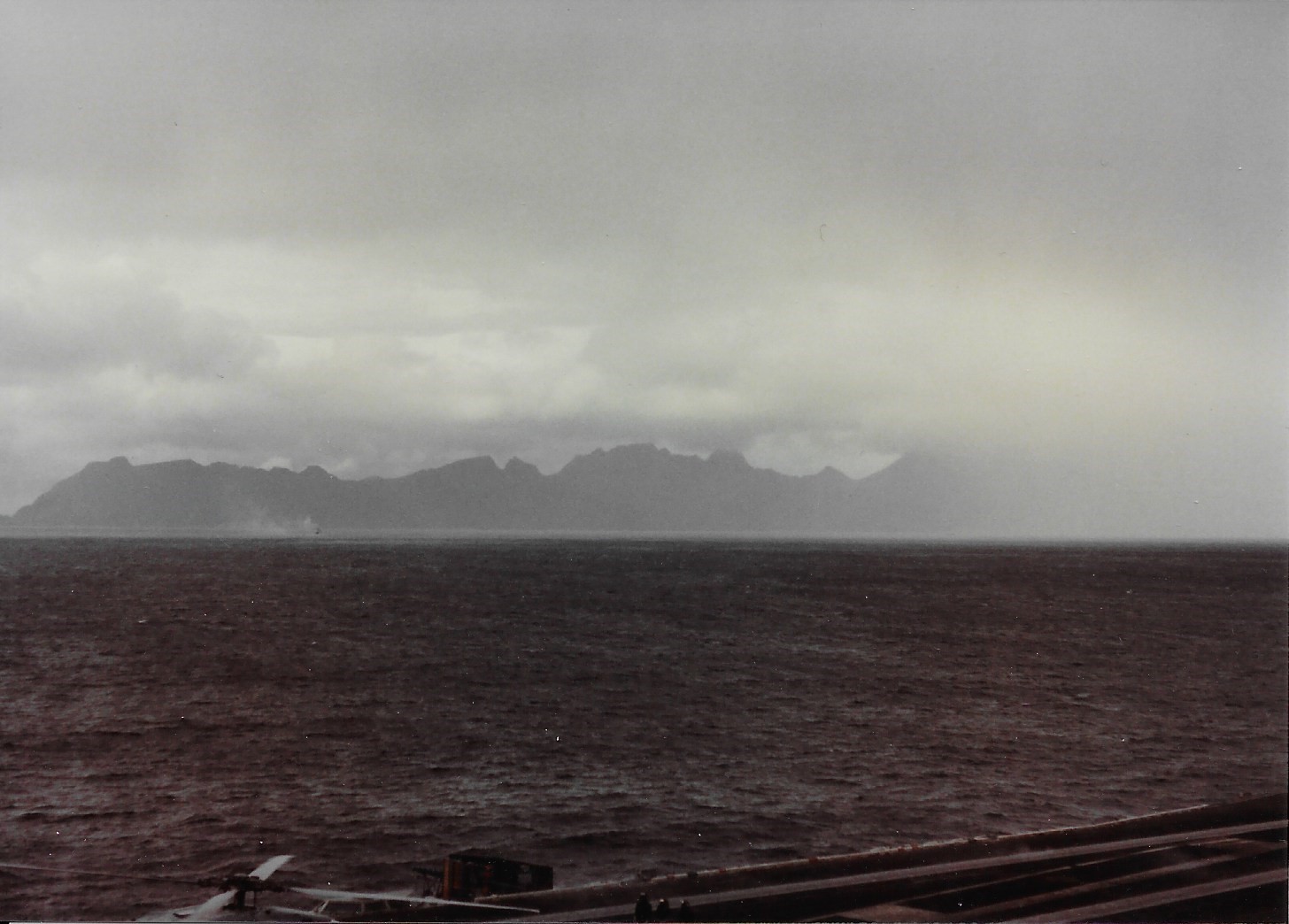
My confidence would be shaken even more when, later, we went after a nuclear boat that had either been in Vestfjord lying in wait after the initial battles or had slipped past our minefields. The contact ranges were crazy-low one day and on the rare days when the water was a glass surface, we seemed to have ranges that went on forever. Among so many other realizations, it was clear that we weren’t preparing ourselves with detailed knowledge of how this body of water, and others like it all around the world, would play against or work for our sensors.
The good news was the submarines were having the same acoustic propagation problems as we were.
We spent several more days in the war against the “Soviets” flying many missions. Towards the end, the USS Forrestal joined us in Vestfjord—the first time, I believe, that two supercarriers had operated together in such an environment as part of a proof-of-concept showing that two full CVBGs could fight the ‘battle of the fjords.’
Surprise Viper Strike
I’ve got to tell you about my favorite mission while tucked away in the Fjord—the one where I got ‘shot down.’ We were launching a full Alpha-Strike and, as usual, the E-2 and the S-3s were first to get shot off the pointy end of the carrier.
I watched the E-2 run down CAT 1 (catapult one). Then it was our turn. As we went down CAT 2, I noticed a sudden flash go across the windscreen, about 500 yards off the bow. We got airborne and then another flash went by followed by flares popping out everywhere it seemed. At that point, we heard the Air Boss on guard frequency yelling at the attacking Norwegian F-16s (simulating Su-24 Fencers) to get the hell out of HIS air space, because they were endangering the launching aircraft!
Well, two immediate things struck my mind. First, I didn’t get the chance to hear what laughter sounded like in Norwegian because none of the F-16 pilots responded and the attack ended as quickly as it started. But I’m sure there was plenty of laughter and joy because these great pilots left a flaming strike force on the deck of the mighty Theodore Roosevelt and my helpless S-3 got shot down, as well as the E-2 and another Viking that was launching off one of the waist catapults, in the process.

On the other hand, I participated in the laughter in my cockpit as we all realized just how pure the brass was on the pair of balls each of those Norwegian pilots had. We also realized just how serious the people of Norway were (and are) about training for war since they lived under the shadow and certainty of attack from the Soviets and the memory of WWII. Those pilots didn’t give a shit about the ‘Boss’s’ precious air space. They wanted to teach the United States Navy and NATO the reality of the old adage:
You fight the way you train.
My crew and I were convinced and I’d like to think that any protests that were offered to the Norwegians about this attack were presented with a knowing smile.
What an amazing time it was up there, above the Arctic Circle, training for World War III during the final throws of the Cold War.
The Crash
After the intense ops in Vestfjord, the TR and her escorts made their way to Wilhelmshaven, Germany for a well-earned port call. The air wing was invited to participate in one of the legendary “fly past” airshows being held at RAF Abingdon in Oxfordshire, England. Feeling quite fortunate to have been picked for this event, I manned Scout 710 with pilot Lt. ‘JT,’ Co-pilot/Tactical Coordinator (COTA) Lt. ‘SM’ and because we were going to an unfamiliar airfield, an Aviation Electrician’s Mate, AE3 ‘JR’ was joining us. He sat in the Sensor Operator (SENSO) seat, while I took the Tactical Coordinator (TACCO) seat.
We launched from the boat just as the TR entered the North Sea, an hour or so ahead of the other CAG-8 aircraft—one aircraft from each squadron, except one from our embarked helicopter squadron, HS-9. The combination of being worn out from the high-tempo ops and having to wear our drysuits made the flight seem longer than it actually was. Of course, I had to play with the radar and was awed by the on-rush of history as my APS-116 painted the English coastline. I was sharing the airspace that had been traversed by He-111s, Spitfires, Bf-109s, Ju-88s and Hurricanes during World War II.
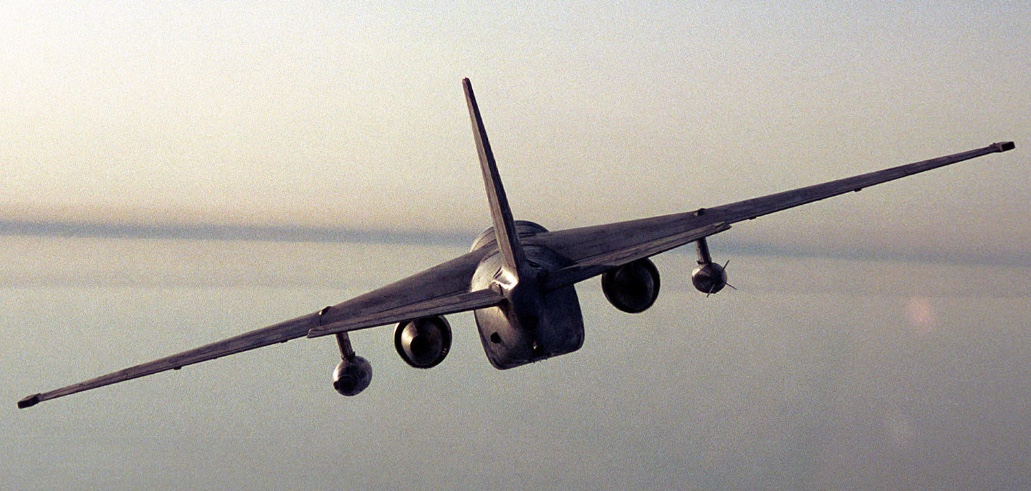
Once we were ‘feet dry’ (over land), I finally understood all the talk about the English countryside and its patchwork quilt of farmland and hedgerows. Even from the tiny TACCO’s window, it was an absolutely magical sight to behold.
Our approach to RAF Abingdon was routine. However, as we entered the break running north to south over Runway 18, I distinctly heard the tower give us clearance to land calling the winds out of the west at “10 to 15 knots.” My pilot took note and discussed the direct crosswind with the COTAC as they went through the landing checklist amid the sound of deployed airbrakes, extending flaps, and lowering landing gear.
Keep in mind, since the carrier tends to launch aircraft into the wind and recover them with the winds almost always straight down the angled deck, my pilot didn’t encounter many opportunities to perform a crosswind landing over the past month. So, as JT attempted to put three landing gear on the northern end of Runway 18, we were all very surprised to find ourselves over the rich green English grass growing along the left side of the runway.
Instead of 10 to 15 knots, the direct crosswind was gusting up to 30 knots and was using our relatively large aircraft, that happens to have a particularly large tail, as a sail. JT fought to get us back over the asphalt-concrete mix, but our introduction to British windsurfing ate up nearly half of the runway.
Realizing how far along we were, he called for the tailhook to be dropped by LT SM as all three wheels finally found the deck. However, the hook either skipped or came down too late to engage the single down-field emergency arresting wire.
Once we had settled on the runway, I craned my upper body around the TACCO’s console—at least as much as my upper straps would allow—to see what the front-seaters were seeing. By doing so, I had thoughtlessly taken myself completely out of the ejection envelope. What I saw was a bit unnerving—a rapidly ending runway, a fast-approaching grassy field lined at the far end by one of those magical hedgerows, and a fence. Even more disturbing were the requisite British ‘aeroplane spotters’ standing along the fence line…and, ‘oh shit!’ a small van just went speeding across the windscreen from left to right along the narrow single-lane country road that ran along the southern edge of the airfield! And another…
‘OH, SHIT!…’ We weren’t stopping.
Then, the COTAC said “Hold on, boys, we’re going for a ride!”
Okay, so time slowed down in my mind to the speed required to ponder the various possible interpretations of what LT SM had just said. And then my mind started to race: ‘going for a ride?’ Van just flashed by—is there more traffic? Fence! People! Grass! All of this thankfully shocked me back into reality and time resumed normal speed. I immediately repositioned myself in the proper body position just in case the COTAC was reaching for his ejection handle.
The last thing I saw out the aircraft windscreen as I pulled myself back into my seat was all the plane-spotters scattering left and right to get out of the way of the approaching U.S. Navy aircraft, loaded with four colonists, about to join them on their prime airplane-watching real estate.
No ‘BOOM!’ of the ejection seat. No rocket motor firing, no rush up the rails and through the skin of the aircraft.
Whew!
Along with the thick English grass, my pilot’s thicker flight boots—which were pushing the top of his rudder pedals, slowed us down considerably. After a final jolt, we simply came to a stop on Barrow Road. Unfortunately, our fuselage, nose wheel, and left main mount were now blocking the flow of any Friday afternoon traffic.
JT had wisely shut down the engines as we crossed onto the grass to keep from FODding one or both of them. I didn’t notice how quiet the cockpit was until the COTAC called to safe the ejection seats in a calm, professional, military manner.
Once all four of us acknowledged “head-knockers down,” I made sure AE3 JR was okay and unstrapped myself in order to check the avionics tunnel for smoke or possible fire. More awareness came as I noticed that the aircraft had come to a stop at a slight right wing down attitude. In light of that final jolt, I wasn’t sure if the main gear had collapsed or the crew hatch might be blocked by the fence, the hedge, or the roadway itself. If so, we would most likely have to egress through one of the hatches above either the SENSO or TACCO seats.
Again, thankfully, the hatch opened as it should and we all climbed out to inspect what damage had occurred just as the Abingdon crash trucks were arriving.
To our collective surprise and my pilot’s relief, there was only minor damage. The main gear tires had excessive wear and the brakes were understandably smoking but had not yet caught fire. All the landing gear were down and locked and in excellent shape.

It’s funny. Arrested landing after arrested landing aboard the carrier and I’d never given the landing gear’s durability a second thought. Now, after going four-wheeling across the English countryside, I was ready to kiss the hands of the Vought team who were wise enough to use the F-8 Crusader’s rugged main mounts and the A-7 Corsair II’s nose strut when Lockheed asked them to help with the design of their first carrier-based aircraft.
We also inspected the engine fan blades discovering they had no damage and only a minor amount of paint was scraped off where the lower leading edge of the intakes made contact with the fence. Finally, a lookover of the radome revealed only a minor gash from where the fence attempted to resist this 20th century Viking onslaught.
It was on this day that my respect and love for the Viking exceeded all prior indifference I might have had.
We waited for a tractor to tow our aircraft back to the flight line and once she was hooked up, we began to walk to a van the RAF had sent to retrieve us and whisk us away to the base dispensary to perform the requisite post-mishap pee-in-a-bottle. All of the excitement made me forget that my tired body was still wrapped in a dry-suit. It would be good to get out of the damned thing.
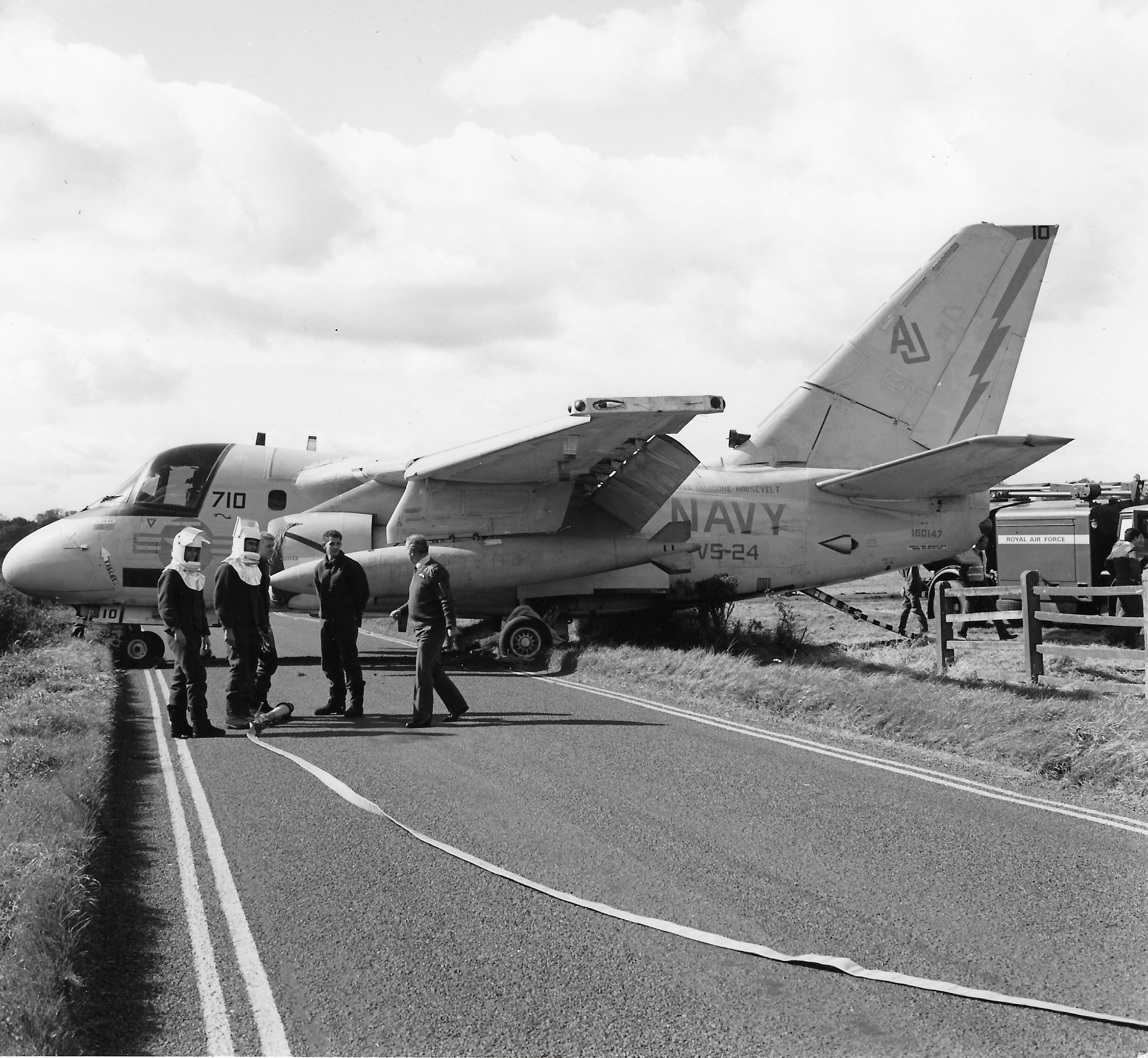
Overhead, a barely noticed Hawker Hunter had been making several low passes over the field. Now, we were all watching as she passed over our heads with her wheels down, about to land on Runway 36.
A collective gasp could be heard from all of us as we witnessed the effect of another strong gust of wind and the vulnerable Hunter was pushed onto her side, her right wingtip nearly connecting with the ground. The pilot recovered admirably, flying off with full throttle and raised landing gear—as we all wished we had done. Someone wondered aloud if the tower had, once again, failed to warn of the gusty crosswinds.
Just an hour or so later, after we had returned to our aircraft, I was inside the cockpit working with LT SM to get the auxiliary power unit (APU) started. We felt the earth move as if from an impact and then heard the explosion. We quickly stepped outside to witness a fireball rising into the sky just a few hundred yards away from where we were parked.
A bad day for us had just gone tragic for Flight Lt Chris Lackman and Flight Lt Jack Thompson, the pilot and Weapon Systems Officer of an RAF F-4M Phantom FGR.2. I’ll let the narrative from Aviation-Safety.net explain what happened:
On 23 September, 1988, [d]uring aerobatic practice at Abingdon, Oxfordshire, the aircraft performed a loop manoeuvre immediately following a 360-degree hard turn. The manoeuvre appeared slower than normal and the pilot was unable to recover from the loop. The aircraft struck the ground on the airfield tail first in a nose up attitude and exploded killing both crew.
Also, I recently learned from this blog that Chris Lackman had transitioned from the Vulcan to the Phantom and flew as a co-pilot on the Black Buck operations during the Falklands War. The loss of any aircrew is tragic, but when you learn things like this about pilots and crew who had served in such significant historical events, well, it adds an unbearable weight to the story.
Finally, one of my British hosts told me that Lackman and Thompson’s fellow aviators would come together at the Officer’s Club back at the Phantom’s home field and have a drink on the lost aircrew’s tab. The tab would then be closed out.
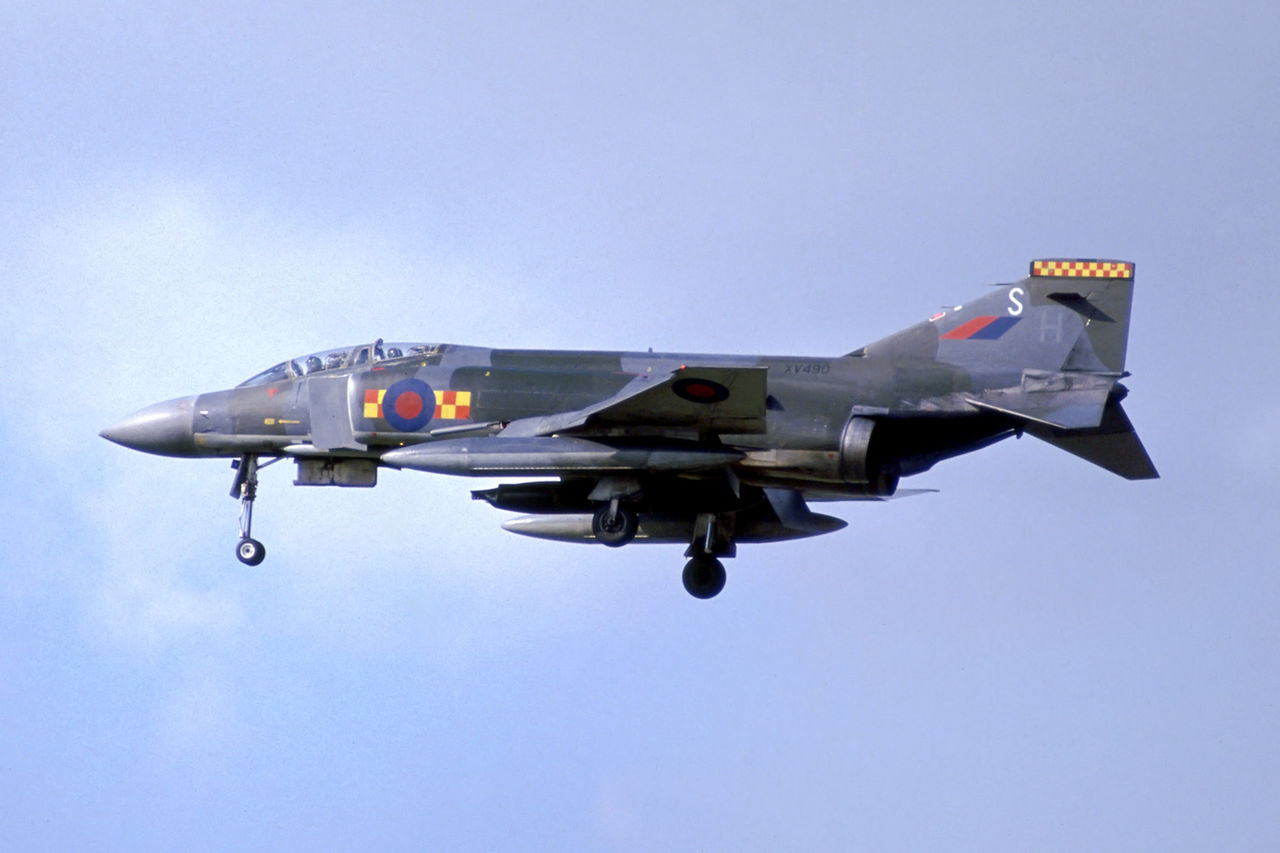
Over the next 10 days, a small team of our squadron techs and mechs who had flown over from Wilhelmshaven, along with our XO, checked the aircraft over completely, replacing all the tires and brakes. If memory serves, a strip of duct tape ensured that the gash in the radome would not affect aerodynamics. They also discovered that the seemingly fragile electronics had suffered no ill effects.
This amazing team, who had been ordered to volunteer to give up their liberty in Germany, ensured that aircraft 710 was fully airworthy. Thankfully, they did get to enjoy the British nightlife after each day’s work on the bird. Oh, and they were happy about one unexpected benefit of their volunteering: they didn’t have to share Oxfordshire with 6,000 other American sailors.
The Theodore Roosevelt pulled out of Wilhelmshaven and passed through the English Channel. With full and heavy hearts, we said farewell to our magnificent RAF hosts and manned aircraft 710. Our XO joined us in the cockpit after we discovered that AE3 JR had a ruptured eardrum from a cabin pressure dump we had experienced on the flight into Abingdon. Once airborne, we headed off the southern coast of England to return to our floating steel runway where the winds were almost always predictable.
Trouble Shooting
And then it was time for another Mediterranean deployment.
This would be the final time the S-3A Viking flew over the Med with Air Wing Eight. Once we returned, we would begin our transition to the S-3B as our sister squadrons on the East Coast were doing. For now, we still had to deal with the limitations of the “A” at the end of the 1980s which meant the uncertainty of the computer working after a launch.
Our software engineers at VX-1 were always working with the manufacturer to fix the problems we faced, but they never went away completely. As is the nature of the Fleet sailor, we created a work-around.
I don’t recall which squadron initiated this plan, it might have been my Chief Aviation ASW Operator (AWC), he was brilliant like that, but we would now actively troubleshoot our system while airborne. We didn’t mess with the system prior to this because the electronics were expensive and the powers-that-be didn’t want a bunch of angry aviators messing with their stuff. However, our Naval Flight Officers (NFOs) and Chiefs argued to the point we were given the go-ahead to try and make the system work.

Here are some of the things we did: just in case the Tape Transport Cartridge (TTC) wouldn’t load, or we had problems in flight, we sometimes brought a second one with us. If the OL-82A Acoustic Data Processor (ADPS) was giving us headaches, we learned to pull circuit breakers associated with specific elements of the system. Sometimes, a simple reset of the circuit breaker was all that was needed to fix the problem. If not, we’d pull them again and wait for the memory drums to slow to a complete stop. We would then pull the boxes from their connecting pins, inspect the rack and area behind the boxes to make sure nothing was out of place or broken, and reseat them…gently—they were very fragile and broke easy, particularly if an angry SENSO slammed the box back onto the pins.
Nine times out of 10, this worked! We started doing this with any system that failed and the days of having a malfunction and having to orbit overhead the carrier were pretty much gone!
Photo Bombing
We entered the Mediterranean during the first of January just as we had on Nimitz two years before. This time, however, a Soviet escort wasn’t waiting for us. Perhaps this was a sign of the times.
On the 15th January, 1989, we met the USS John F. Kennedy (CV-67) and transferred weapons. We then relieved the JFK and took on the mantle of Sixth Fleet Battle Force.
We operated in the Western Med and then anchored off the island of Palma de Mallorca for our first of many port calls. Already, we noticed a huge difference between this cruise and the one on Nimitz. We averaged four to seven days in each port instead of the meager two to three days at the most in 1987.

Back at sea again, we joined the French aircraft carriers Foch and Clemenceau for Phinia ’89, a major amphibious exercise. I’ll let the UPI news release tell the story:
French, U.S. troops begin war games
TOULON, France — French and American troops prepared to invade a Mediterranean island and evacuate its population during 10 days of war games that began Sunday off the coast of Corsica, military officials said.
Three aircraft carriers and 14,000 French and American soldiers were participating in ‘Operation Phinia 89,’ the largest U.S.-French maneuvers since war games in the Persian Gulf in 1987 and 1988, French military officials said.
U.S. Marines, French Navy commandos and rapid deployment forces planned a coastal invasion of the French-administered island of Corsica Monday to evacuate the population from a ‘hostile environment.’
The maneuvers, directed by a French naval command center in Toulon, were being carried out from the French aircraft carriers Clemenceau and Foch and the U.S. aircraft carrier Roosevelt using the French landing ships Ouragan and Orage, the U.S. amphibious assault ship Guadalcanal and U.S. amphibious transport vessel Austin.
So, did any of you ever have to do that school science project where you drop an egg off the roof after having built what is hoped to be a durable container that will allow the egg to survive fully intact? We’ll come back to this in a moment.
One of the things we learned from this exercise was how the Marines weren’t able to get relatively real-time reconnaissance photos of the battlefield they were fighting on. Remember, this was 1989. We needed to figure out a way to get Tactical Airborne Reconnaissance Pod System (TARPS) photos taken by the Tomcats, whether of a changing battlefield or Bomb Damage Assessment (BDA), developed and analyzed and then transmitted to the boots on the ground.
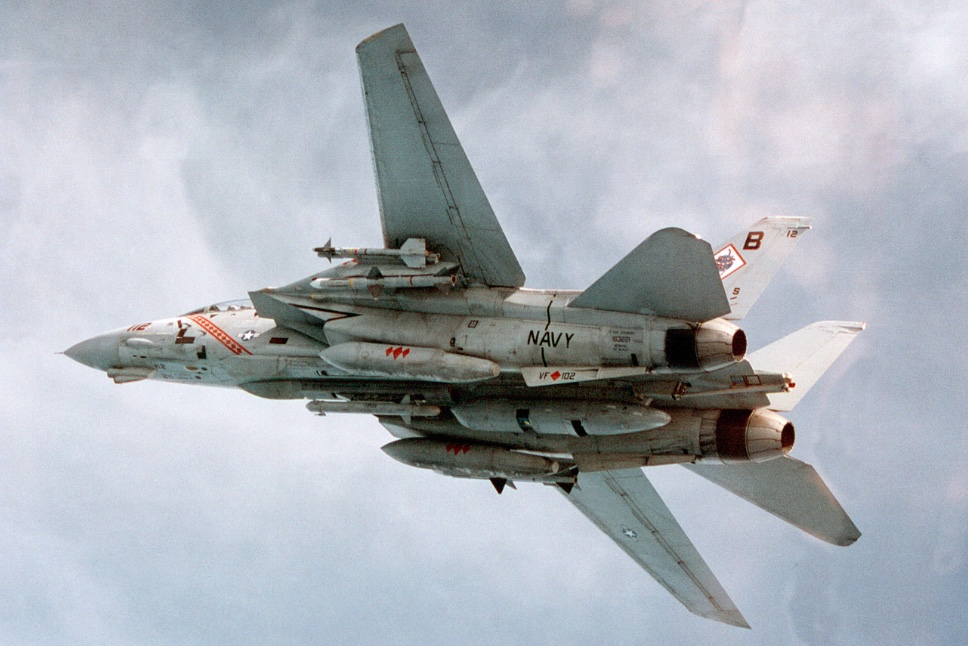
Some of our genius NFOs worked with Carrier Intelligence Center (CVIC) and came up with a styrofoam container and some other material (I don’t have a clear memory of it, just the event) that the photos could be stuffed in and we would launch it out of one or more of our sonobuoy chutes. They worked on it for a couple of months and ended up testing it during another exercise where the Marines were doing an amphibious landing.
I was on that flight.
We launched and headed to rendezvous with the Marines. Everyone was excited to see if this would work. We established comms with the ground Forward Air Controller (FAC) on the shoreline. The idea was to jettison the…well…egg…into the surf so the Marines wouldn’t have to go too far out and get it. We would also launch one over the sand to see if it would survive.
The FAC cleared us in and we punched out two containers. We then flew away while they retrieved them. Then, we were called in for the beach drop. Apparently, they were having a hard time breaking into the containers because they were packaged so well. So, we said our “goodbyes” and headed out on our secondary mission.
Upon returning to the boat, we all went into CVIC to find out what happened. As I recall, only one package survived the water landing (I think saltwater had penetrated the container and ruined the photos). The beach drop failed completely.
I never did do that science project at school and I’m not sure if anyone involved in this project did either. The concept was a good one for that time because, as I said, there just wasn’t any way to get those much-needed photos to the Marines faster. However, our idea simply didn’t work. But you gotta hand it to the S-3—fulfilling its role as NAVAIR’s Swiss Army Knife, she answered the call to perform yet another uncanny mission.
Rough Rest
After the amphibious exercise, we pulled into Marseilles, France for another port call from the 10th to 17th of February. However, as was the case with winter in the Med, storms came along and made things interesting.
I was sitting in the Ready Room when we heard the call to “set the special sea and anchor detail” over the 1MC (ship-wide address system). This was very unusual since we still had a couple of days left in port. I believe either the XO or Navigator of the TR then came on and said we were having to repeatedly “sail to the anchor.”
A ‘mistral’ wind apparently caught us off guard and the CO of the boat decided it was too risky to attempt to stay at anchor. A mistral is a windstorm unique to that part of Europe, where winds are funneled from a high-pressure area off the northwestern and western coasts of France, down across the country through two river valleys, and out into the Med. This combines with a low-pressure area off the southern coast of France. The blow can sustain 60 knots and gust over 100. It can also last for up to a couple of weeks.
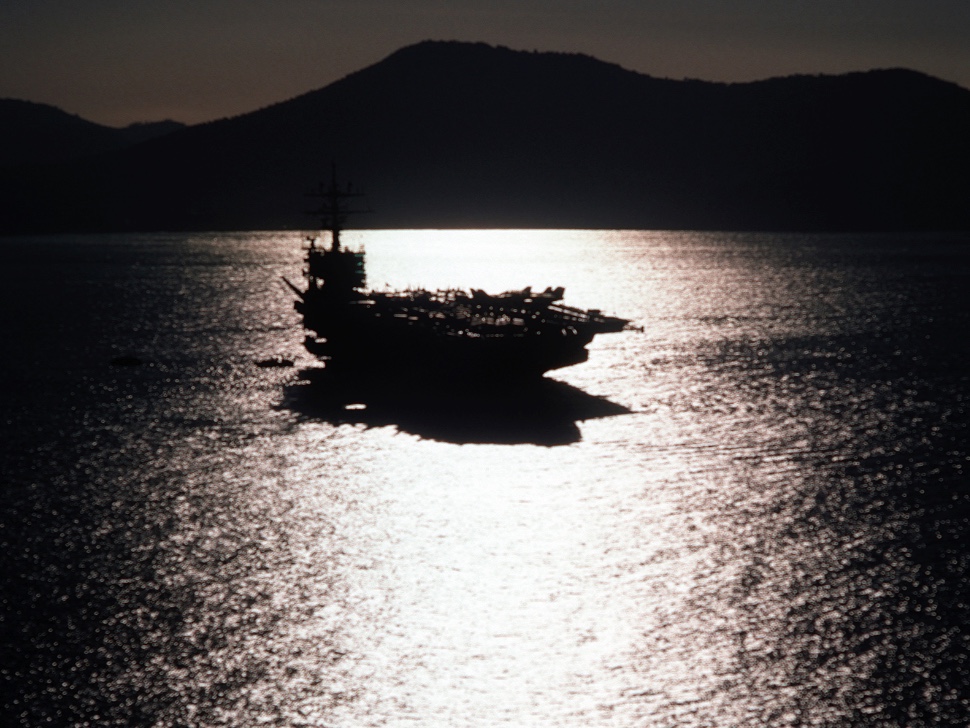
The order was given to do an emergency recall of all the ship’s company and members of the air wing still onshore. This was done in a very unique manner that we all were briefed about. I won’t go into exactly what it was because it still may be in use today. Unfortunately, not everyone could get back to the boat.
We were in danger of grounding, so the Skipper went ahead and executed an emergency sortie. It was my understanding that many of the soon-to-be stranded sailors were already heading to the boat in ferries provided by France. What a sight that would have been to see your aircraft carrier leaving without you! But two days later, we returned and picked up the rest of the crew.
Hey, the commercial did say “it’s not just a job, it’s an adventure!” right?
Sub Hunting From Sicily
With our full complement of sailors, we headed back out to sea and transited the Straits of Messina. From there we headed to the waters off Libya since Gaddafi was rattling his saber. For this period, the commander of the Navy’s Sixth Fleet (COMSIXTHFLT) decided to join us, just in case. Apparently, Gaddafi lost interest and we headed off to Alexandria, Egypt for yet another port call!
While there, the Egyptian Navy provided protection for our ships. For some reason, I had been asleep when we dropped anchor. Late in the day, I got up and went to the ready room because I was the night ASDO and was told by my fellow AWs that I had missed the Romeo class submarine that had sailed past us a couple of times along with some Osa II missile boats. I was pissed! Why the hell didn’t you wake me up?! The bastards! An AW not getting to see a submarine passing next to his aircraft carrier…!?
After the visit to Egypt, we headed back into the Eastern Med and conducted flight ops. Just prior to our visit to Antalya, Turkey—a favorite of mine—one of our aircraft had a major incident.
After leaving Turkey, it was my turn to head off to Naval Air Station Sigonella (“Sig”) in Sicily for a two-week detachment (DET). We took two aircraft to replace the ones that had been there already.
It was simply a fantastic time getting to leave the ship and continue flying missions. This would be one of two DETs to Sig I got to go on. During this first one, I experienced the drastic difference between the VP (P-3 squadrons) and VS (S-3 squadrons) philosophy of how we flew our missions.
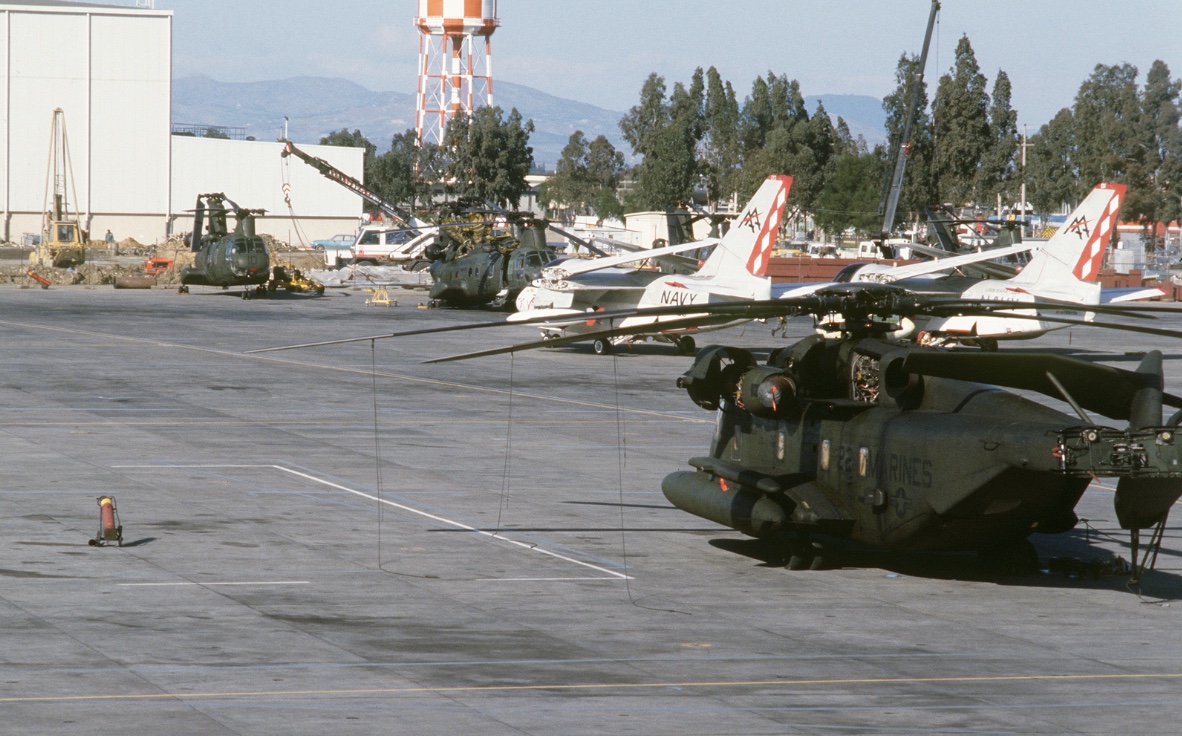
There was always a VP squadron at Sig. On a particular day, we and a P-3 crew were tasked to do a photo recon flight over the Soviet anchorage at Hammamet, just off the coast of Tunisia. The ASW Operations Center (ASWOC) at Sig wanted to know which Soviet warships were there, as well as if a missing Tango class diesel submarine might have turned up.
Yes, a missing Tango.
They started the briefing, giving us flight information and reminded us to stay out of unfriendly airspace. We received intel briefings on the ships expected to be at anchor and how the Tango had slipped into the Med through the Strait of Gibraltar and then disappeared. After the weather brief, the ASWOC crew told us that was it for us. The P-3 guys, on the other hand, would now be individually briefed in detail. We shrugged our shoulders, knowing that that was all we needed anyway, and headed out to our airplane.
We launched out of Sigonella and immediately headed south across the Med to Tunisia. I was, of course, sweeping the whole area with radar checking to see just what we might encounter as we approached the anchorage. There was a single, large contact there and a few small ones. I dropped the FLIR in an attempt to identify everything before we ventured in to get some photos.
It was just a Soviet auxiliary and small boats…no warships…damn!…and no Tango…double damn!

We took some photos of the vessels and then headed out to the western coastline of Sicily. My pilot wanted to do a low-level from west to east. On our way, we plotted all the shipping traffic and sent the surface plot to the ASWOC via Link 11. I used the FLIR to ID some of them, making sure none of them were combatants.
We entered the low-level route and flew across the gorgeous Sicilian countryside. Just like England, it was breathtaking. At times, looking out my very small window, I had to look up to see the hilltop villages we flew beneath!
After the run to Hammamet, the surface plot, and the low-level, we were done. So, we returned to NAS Sigonella, entered the break and landed. As we were taxiing up to our parking area, we all noticed that the P-3 crew we had briefed with were just finishing their engine start and had begun to taxi.
We had launched, flew our mission, did a low-level, and landed in the time it took them to fully brief, pre-flight their aircraft, and start-up! I think it took almost two hours for our flight.
Of course, they were going on a 10 to 12-hour mission, not only to check on the Soviet anchorage, but to provide a much more detailed surface plot for the ASWOC and Sixth Fleet. They would also be dropping and monitoring a sonobuoy search pattern in hopes of netting that Tango. A helluva lot more to do than we did. Still, it was such a contrast between our two communities and the way we flew our missions.
Two weeks went by entirely too fast. We worked with the TR which was sailing all around the Med during my time in Sig. Let me list her gyrations for you: once again she had to tend to Gaddafi’s saber-rattling from 12-13 March. Then, she headed up to Naples, Italy for a five-day visit from 15-20 March. After that, she headed for Morocco and a rare two-day port visit. The central Med was calling and she proceeded to the fleet anchorage in Augusta Bay, just off the east coast of Sicily. For two days, the commander of Sixth Fleet hosted the Secretary of the Navy and our Mediterranean allies for a major naval conference on 29 and 30 March.
Quite the itinerary for a Carrier Battle Group!
She then weighed anchor and headed back to the Western Med where we flew out to rejoin her. We landed just in time for…another port visit! This time it was Toulon, France.
The weather once again picked up as we left Toulon and things quickly went from bad to worse. As a result, we made headlines when HS-9 and our escorting cruiser, USS South Carolina (CGN-37), participated in a major rescue at sea. The official USN history of the carrier tells the story:
A routine transit between port calls in Toulon and Monaco became drama on the high seas for USS THEODORE ROOSEVELT. Aircraft from Helicopter Anti-Submarine Squadron NINE (HS-9), embarked with CVW-8, aided by TR and USS SOUTH CAROLINA (CGN-37), rescued fifteen British yachtsmen from four sailboats foundering in hurricane-like seas. The sailboats were part of a 16-boat flotilla sailing from Toulon to Corsica. Search and rescue swimmers from HS-9 entered the chilly water in waves estimated at 35 feet and winds clocked at 70 knots. One survivor, who suffered a broken leg, was airlifted to Toulon for treatment while the others walked ashore the following day when TR arrived in Monaco. The rescue was broadcast on television in France, Italy and the United Kingdom, and reported in newspapers around the world.
I watched this drama unfold from the safety of the ready room, of course. We weren’t allowed to go on deck because of the 70 knot winds. It was stunning to see the aircrew and maintenance personnel fight just to get to the spots on the waist where their birds were tied down. The pilots masterfully got the engines and rotors started and lifted off to save those folks. Once on scene, the helo AWs then jumped into those 35-foot seas!
Such amazing souls manning those helicopters. In my mind, no one will ever approach the greatness and heroics of a Rescue Swimmer.

After the relatively short port visit to offload our guests and enjoy an always beautiful and towering Monaco, we headed back to sea for Dragon Hammer ’89 which ran from 20 April to 02 May. The AW who flew in this year’s rendering of the major Med exercise was not the same AW who flew in it back in ’87 off Nimitz.
I was a completely different person.
It was during this event that the S-3 Viking was paid the highest compliment she could have received…from a submariner.
The skipper of a Rubis class nuclear fast attack submarine (SSN) operating as an orange force (aggressor) boat sent out a message to COMSIXTHFLT expressing his deep frustration that every time he extended a mast, his ESM system (electronic support measures used for electronic intelligence gathering) picked up the S-3’s APS-116 radar. He said it made him extremely wary of being at periscope depth where he needed to be to get intel on the position of the ship. He congratulated VS-24 on our effectiveness at keeping him on edge and limiting his ability to target the carrier.
Someone said his flare (to signify he had fired on us) was the prettiest shade of green…
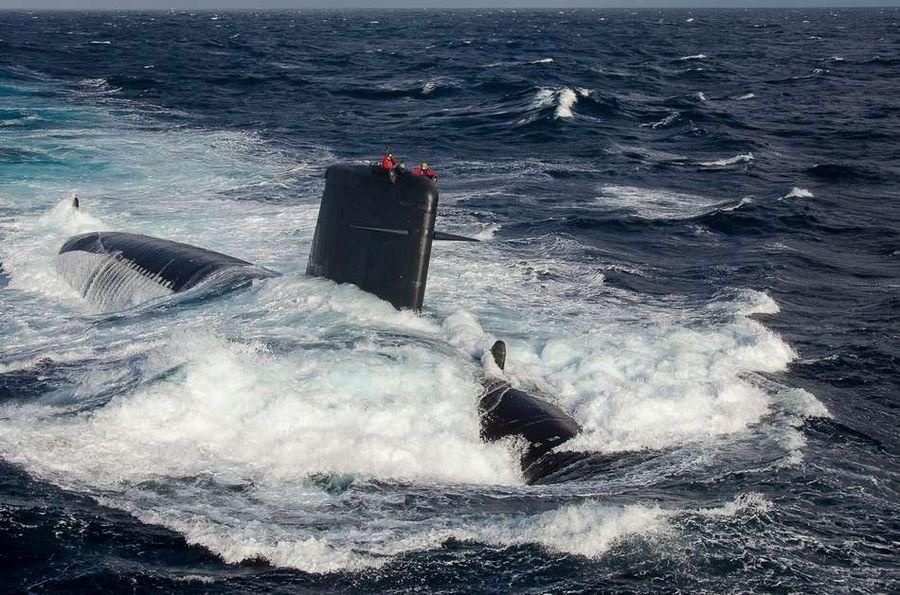
After the exercise, we sailed to Haifa, Israel for another of my favorite ports of call. While we were there, members of the Israel Defense Forces (IDF) were given tours of the carrier. I was on duty during one particular day and was delivering something somewhere on the ship when I entered a ladder well.
Coming down the latter were several members of an Israeli Airborne unit. I stepped aside to allow them clear passage. As one of the officers turned toward me our eyes met. He smiled, appreciating that I had given him and his men room to maneuver in the tightness of the compartment. His smile and face were kind, but his eyes…his eyes were oceanic blue and had a depth to them that I had never seen in a pair of human eyes. A depth that told me stories of the life of a genuine warrior who had done things and seen things I could never comprehend.
They were the coldest, deadliest eyes I had ever seen…I will never forget them.
When we pulled out of Haifa, I was told I was going back to Sigonella for another two weeks. An Echo II submarine had entered the Med and the carrier was going to transit all the way back to the Balearic Sea, just off the coast of Spain, with the hope of allowing the CVBG escorts some “time on-top” of the Soviet submarine. We would be flying against the Echo II, as well. The boat was scheduled for a second visit to Palma de Mallorca, which was everyone’s favorite.
I was not the slightest bit disappointed that I would miss it.
After we arrived at Sigonella, I got only one opportunity to fly on the Soviet boat. We launched and headed out over the central Med. At least two of the Roosevelt’s escorts were holding contact on the Soviet guided missile submarine (SSGN).
Years before, the USS Moinester (FF-1097), a Knox class frigate, had led the way in operational and tactical development of the towed array sonar system. She was one of our escorts and was joined by the Spruance class destroyer USS Moosbrugger (DD-980).
“The Moose,” as we affectionately called her, was manned by the greatest anti-submarine warfare crew…ever! To give you an idea of the captain and crew’s outstanding personality, she had a rack of moose antlers mounted to the bridge superstructure!
Unfortunately, (and with no disrespect intended to the Skipper and crew of the Echo II), these two ASW warriors weren’t faced with a very challenging subsurface target. This Echo II class was a very noisy first-generation nuclear submarine, the last of which the Soviets commissioned in 1967. This crack ASW team deserved a Charlie II or an Oscar, at least.
We were vectored in by the “Moose” and dropped buoys on the Russian sub.
Instant contact!
We ran her into an attack barrier and just as we were making our run, I noticed a significant change on her acoustic signature…something I hadn’t been trained for. It was nothing significant, but it reminded me that I still wasn’t the ASW expert I should have been and needed to be.
She was coming to periscope depth to take a look at the newest hunter that had arrived to harass her. I felt sorry for the Skipper, knowing that every time he raised his periscope a NATO aircraft filled his impotent crosshairs.
We made a low pass over her and we were joined by an SH-60B Sea Hawk from the Moosbrugger. It was our attack run, but we didn’t open the weapons bay doors. The crew of the submarine was humiliated enough and it probably would have created an international incident.

In what felt like 20 minutes, the four-hour flight had come to an end. The Echo II returned to her cruising depth, never finding the carrier. We checked out with the ASW commander on board the Moose and headed back to Sigonella.
On our way back, I started to think about what had just happened. The Cold War was not over yet and, had this been a hot war engagement, I realized we would have dropped a torpedo or two to destroy that submarine. For the first time since I became an AW, I thought about the 100 or so sailors working, living and fighting inside that hull. It struck me that they were human beings, just like me and that I would have to be a part of the ending of their lives had this been a combat mission.
I evaluated my feelings…could I do this? Could I be a part of killing so many souls during wartime? I understood…completely…that they were after my floating home with its 6,000 residents. They, too, would follow their orders and fire their missiles in an attempt to sink us.
Before we entered the break over NAS Sigonella, I knew that I could kill these men if I had to. My time on-top made me see them as the humans and warrior-sailors they were and I respected them and the Soviet Navy more than I ever had because of that flight.
One other thing about my second visit to Sigonella. On the evening of 06 June, I walked into the room of one of my NFO’s where world history was, once again, marking time. On his TV screen, a lone man was standing in front of a column of Chinese Type 59 tanks. The day-old news video showed the tank’s driver trying to move around him and this “Tank Man,” as he would later be known, kept moving in front of the armored vehicle. We marveled at the world that was changing for the good all around us.
Little did we know…
We said goodbye to NAS Sigonella and rejoined the TR. On 15 June we rendezvoused with the USS Coral Sea (CV-43), off-loaded our weapons and handed the mantle of Task Force 60 to her.
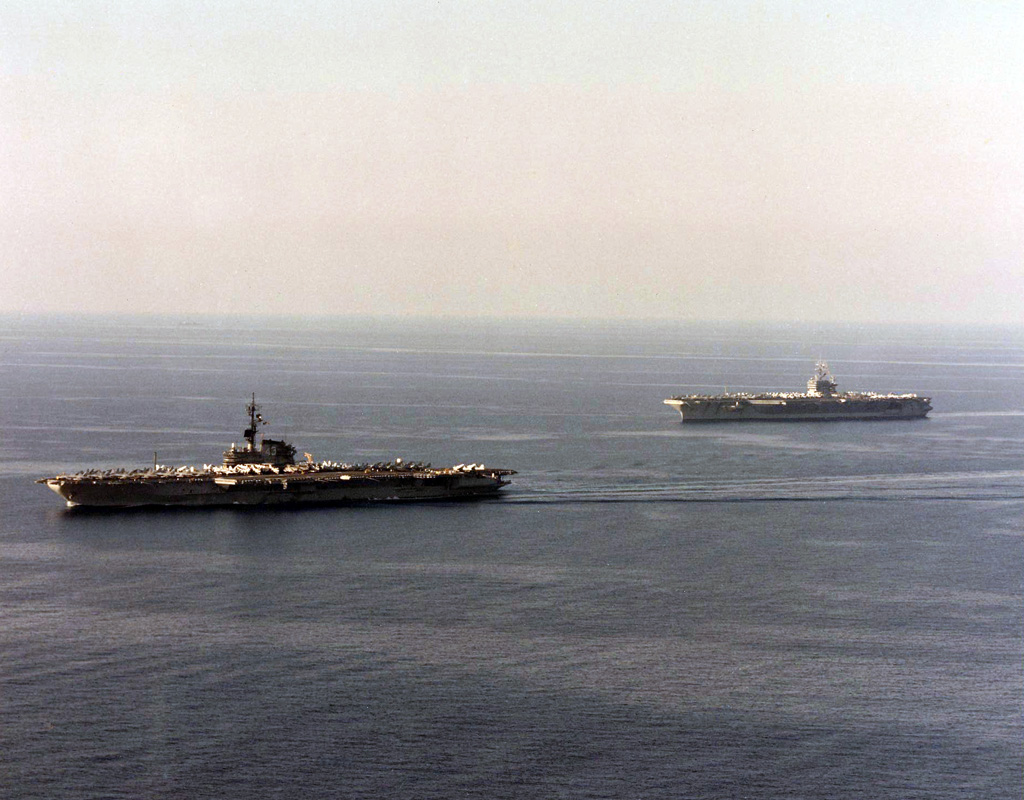
On 20 June 1989, we left the Mediterranean Sea. I would never again sail on these beautiful, emotional waters.
A More Powerful Viking
When we returned from my second Med cruise, our squadron was scheduled to transition to the “B” model of the S-3. We were all excited but we really weren’t prepared for the exponential change that was about to occur.
As we were about to begin the transition, Sea Control Wing One, Atlantic, held its “Crew of the Quarter” competition. In those days, the competition was “flown” in the Training Command’s Weapon System Trainers (WST). This would be the last time a crew flying the “A” model of the Viking would compete.
VS-27’s training building only had one WST left that had the S-3A avionics and simulator software. My squadron, having just begun the transition to the “B,” was chosen to fly against a couple of squadrons that were already flying the S-3B. Unlike the VP community, we didn’t have set crews, so they just picked four of us to go over and fly the competitive mission. For me and the other three, it was a very routine experience.
And, we won!
In all honesty, this really didn’t mean much because we were so well versed in the “A,” and the other squadron’s crews were very new to the workings and manipulation of the “B’s” more advanced systems. The real story was just how different the S-3B’s acoustic system was. There was much more to do in preparation for the hunt and then critical things we needed to do to maintain contact.
Simply put, the “B” crews we competed against were a bit overwhelmed.
The S-3 Viking Weapon System Improvement Program (WSIP) was approved by the Chief of Naval Operations in 1977. Development began in 1981 and the first converted S-3A flew as a “B” on 13 September 1984.
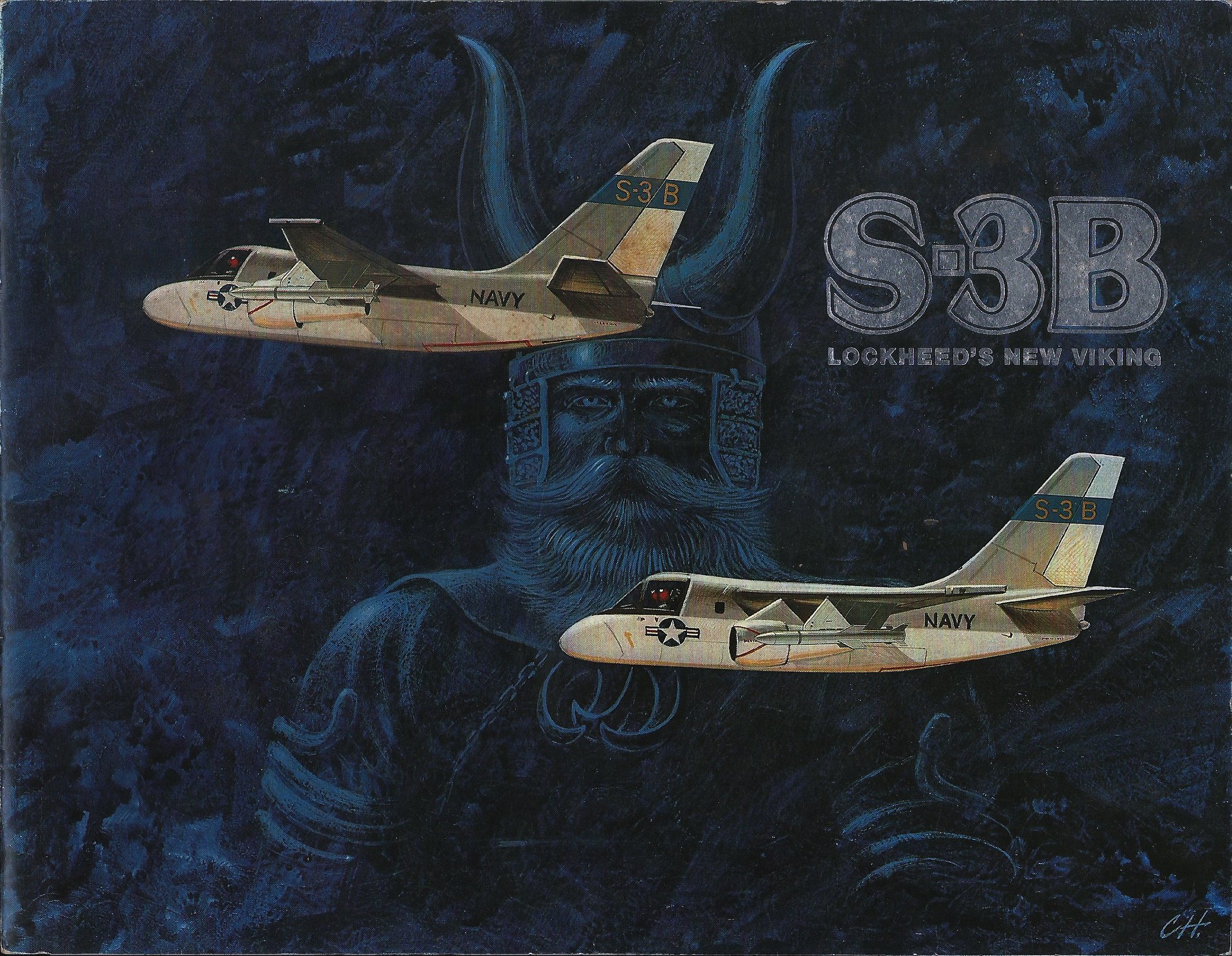
The changes were significant: the APS-116 radar gave way to the APS-137 Inverse Synthetic Aperture Radar (ISAR), which greatly improved its periscope detection capability and, most importantly, allowed us to ‘image’ a radar contact.

Our ALR-47 ESM system was replaced by the ALR-76, which according to Brad Elward in his book The S-3 Viking In Action:
…provided greater frequency coverage and improved bearing accuracy within 2 degrees. The new ESM also gave Viking crews a basic missile threat warning, providing C-band through J-band coverage of both pulsed and continuous wave emissions.
Combining these two sensors made us an incredible war-at-sea asset to the CVBG. It also contributed to keeping our happy asses safe because the missile warning component could automatically launch chaff and flares from the new ALE-39 dispensers placed on either side of the aft fuselage, just behind the main landing gear wheel wells—the primary visual cue for telling an S-3A apart from an S-3B.
Our FLIR was updated and, of course, we could now launch AGM-84 Harpoon anti-ship missiles off of either wing hardpoint. We were also plumbed to carry the buddy store for refueling, as were the S-3As on the West Coast since they didn’t start getting the “B” until the early 1990s. We also got a new, more powerful APU for independent engine start and powering the aircraft for maintenance.
Finally, and what mattered most, was our new IBM UYS-1 Proteus Spectrum Analyzer Unit (SAU) that replaced the OL-82A Acoustic Data Processing System (ADPS). We were now on par with the P-3C Orion Update III and ready for the trend in Soviet submarine quieting efforts born out in the Victor III, Akula, and Sierra classes of SSNs, the Oscar SSGN, and had the Cold War not ended, the very latest Yasen class SSGN.
We also received the capability to monitor 99 radio frequency channels instead of just 31, which expanded our ability to deploy far more sonobuoys without interference between them.
And even though our General Purpose Digital Computer (GPDC) looked the same on the outside, thankfully, it was a completely new computer that could handle so much more processing. And that troublesome TTC? Well, it changed as well. I never had a single problem with the system loading and staying loaded when we were flying off the boat.
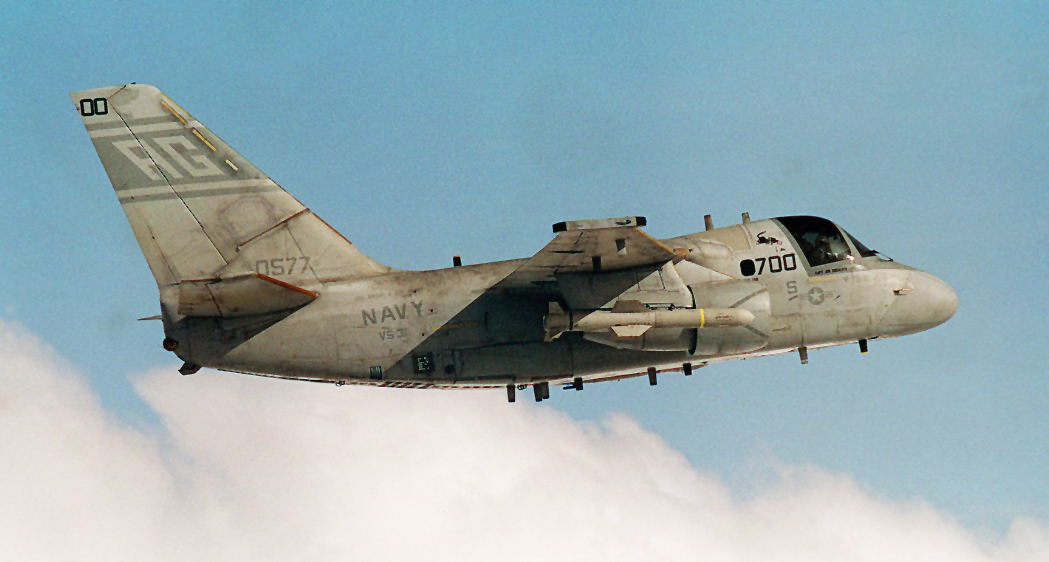
On the outside, the aircraft looked exactly the same with only subtle differences that you had to know to look for. Elward describes just how brilliant Lockheed and the software companies were in making this immense change work with little impact on the jet’s performance:
Overall, the WSIP modifications added a mere 601 pounds to the Viking, changing its characteristics only slightly and maintaining the aircraft’s center of gravity within existing limits. Power consumption for the new equipment increased less than 1KW.
Brilliant, indeed!
As we progressed through the classroom training during VS-24’s transition to the “B,” I was in awe of what our new radar and acoustics could do. As with my training in LOFAR, understanding the ISAR imaging we were seeing was, once again, just like learning how to speak a new language. Initially, I couldn’t see a damn thing except the very obvious Knox class frigate and the box-like geometry of merchant ships. When trying to decipher all the other images from other warships, I felt certain that Texas Instruments (the creator of the APS-137) had hired Hermann Rorschach as a consultant.
The genuine tragedy in all of this? I would never get to take this new weapon system out and fly on top of a Soviet submarine in the Med or the North Atlantic. While I would get to operate the system against USN submarines, drastic winds of change were blowing in 1989 and throughout the early 1990s that would revolutionize everything…
…forever.
The B is for Brilliant
Once we completed the transition to the S-3B, our time on the boat was never the same. We were suddenly the stars of the Air Wing. Everyone wanted our autograph!
Our Vikings were constantly asked to do more and more. Along with the obvious need to refuel CAG-8 aircraft, we were invited to join war-at-sea strikes against surface action groups (SAGs) by providing radar plotting and identification of the targets. Our ESM was recognized as a superior asset for at-sea and overland strikes and instead of just a couple of E-2s or EA-6Bs, the Carrier Air Group Commander now had 10 airframes he could distribute across the wide spectrum for his electronic surveillance needs.
Oh, and we still did ASW, too!

As was the case in 1988, we joined the Theodore Roosevelt frequently for various work-ups that would prepare the air wing for her next major deployment in 1991. We spent much of that time down in the Caribbean participating in a wide range of exercises. I was reaching my peak as an ASW operator and the tools provided by the “B” only made my ability to search, detect, localize, and track a submarine that much better.
On one mission, in particular—one of my all-time favorites—I was stunned to have made contact on three different submarines in the same search pattern. Two were “orange force” aggressor boats playing the bad guys and one was hunting the other two!
A few days later on another of my most memorable flights, my crew was returning to the carrier’s overhead stack in preparation for recovery after an anti-surface warfare (ASuW) mission against a surface action group. We were early and I decided to tune up an old defensive search pattern that had been seeded on the flank of the carrier hours before by a P-3 and S-3. Apparently, no one else was monitoring it.
Earlier in the day, an orange force boat had been ‘sunk’ by an S-3 Viking and an SH-3 Sea King and exercise rules required a sunken submarine to “reset” for a certain number of hours and relocate before coming back into play. Having tuned the buoys up, we started having problems with a particular black box that was unrelated to the ASW system and after safeing our ejection seats, I got up and went into the avionics tunnel to troubleshoot.
As I’m working, I glance back at my display. Lo and behold, a submarine signature started to build very close to one of the tuned buoys. I don’t recall its distance from the carrier, but it was about to arrive within torpedo range. While still in the back of the aircraft fiddling around, I called “subsurface contact” on the buoy. I reseated the black box and climbed back into my seat and informed the TACCO of the unique classification of this particular target.
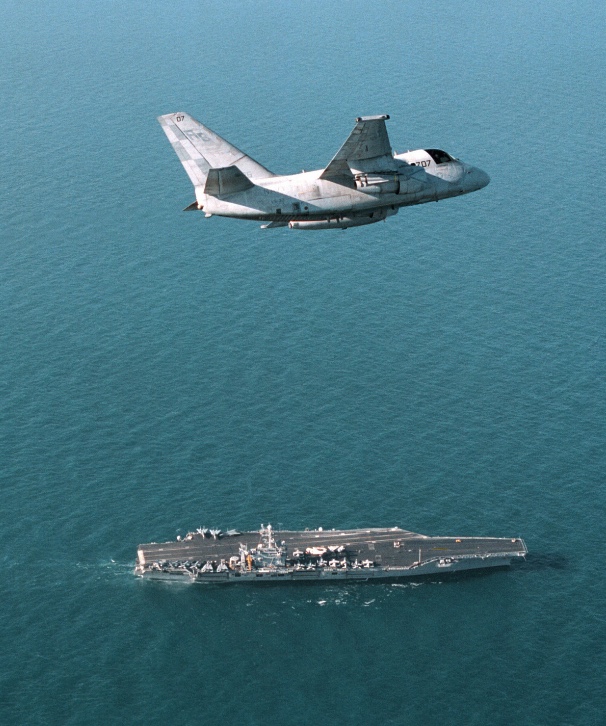
The carrier’s anti-submarine warfare coordination center acknowledged and vectored a newly launched and already-tasked S-3 to the contact. Since we were low on fuel and the mission tanker was topping off the tanks of a strike that had just launched, we were told to land.
When I made my way to the aforementioned operations coordination center to deliver my analog tape recorder of the mission, the guys informed me that the submarine was the one that had been killed earlier. The skipper was “breaking the rules” by coming back into the game sooner than he was supposed to!
This is one of the amazing qualities that submariners are known for…just like those crazy-good Norwegians F-16 pilots, they are notorious for administering a strong dose of reality to a generally unrealistic naval exercise.
Viking Quarterback
It was also during this time at sea that we had the chance to show just how valuable we were to the CVBG with our shiny new S-3Bs. This time it was in the use of our incredible APS-137 ISAR in support of an alpha-strike against a ‘Soviet’ surface action group.
The group was composed of four US warships simulating various units of the Russian Navy. A Spruance class destroyer was simulating a Slava class cruiser, an Oliver Hazard Perry (OHP) class frigate was simulating a Sovremenny class destroyer, another OHP was simulating a Kashin class destroyer, and a Knox class frigate simulated a Krivak class frigate.
Both the surface action group and my carrier battle group were under EMCON (restricted radio frequency emissions control) conditions. We set out to search for the task force before they could target us. To have to face a salvo of the Slava’s sixteen SS-N-12 Sandbox missiles, each with a range of 300 miles at Mach 2.5, was not something any of us had a stomach for.
An E-2 that was already airborne had gotten some over-the-horizon ‘sniffs’ from an SH-60B Seahawk’s radar—the Seahawk would be simulating the Soviet Ka-25 Hormone or Ka-27 Helix helicopter which could provide mid-course guidance for their deadly anti-ship missiles.
Based on the E-2’s bearings, we flew to a certain offset point before we turned on our radar. As I expanded my search, I gained contact on several curious forms that appeared to be sailing together in a loose formation. I switched to ISAR and painted each one. The first two were merchant ships. The next four were…the enemy! There were other contacts around, so it was clear that the SAG was trying to hide among the “lilies of the field.”
They were just about 180 miles from the carrier.
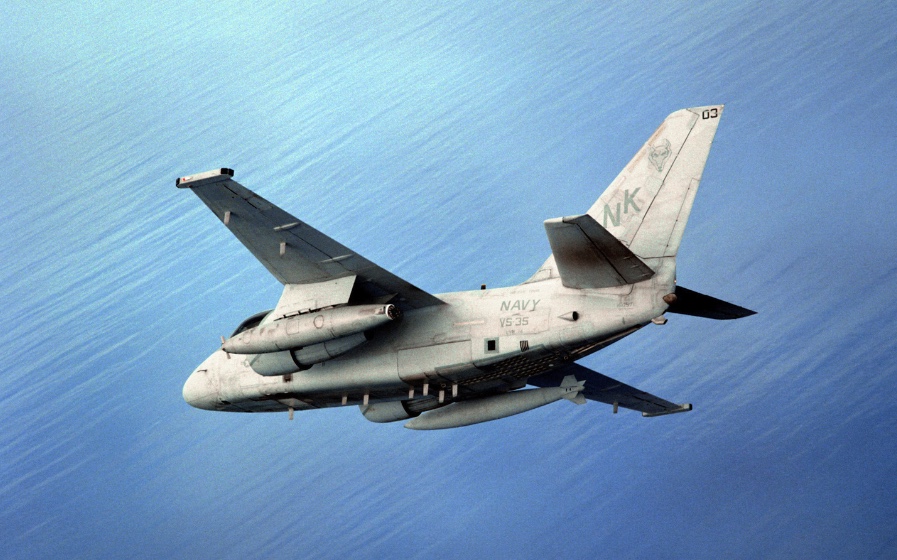
The carrier launched an alpha strike composed of A-6Es loaded with Harpoons, an EA-6B to electronically protect the strike, and some Hornets that were armed for an immediate follow-up strike. Of course, we had our Tomcat combat air patrol already airborne ready to use its Phoenix missiles should the Slava get her needed targeting data. We were well off the strike aircraft’s axis so we, too, were going to fire our simulated ‘Poons to give the surface action group something to think about.
I looked at each warship and identified the class. We then sent the data over Link 11 to allow the strike leader to determine the best approach for the Harpoon launch. They were impressed that we could ID, precisely, which contact was which.
The strike leader called for the launch of all weapons and we simulated the simultaneous release of our two missiles—had this been real, we would have only launched one since we had a buddy store on the left wing. Then, one of the A-6E Intruders broke away from the formation, simulating the flock of Harpoons, and flew out to greet the enemy flotilla.
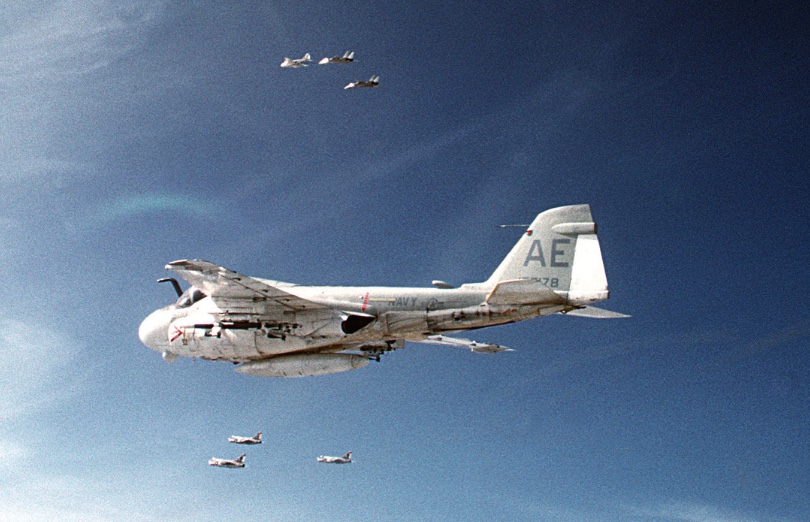
A few hours later, after we had all recovered back at the ship for the day, the CO of VA-36—the Intruder Squadron—came into our ready room wanting to speak to our skipper. His face had a very big smile on it. Not knowing he was the one leading the strike, I listened with deep satisfaction as he described his approach to the surface action group.
He simply couldn’t believe it! Just as we had told him, he came upon each of the warships sailing in the exact formation we had plotted with the exact ship classifications a conveyed…despite the fact that none of us had seen them with the naked eye.
“Fucking magic!” was the phrase he used, if I recall correctly.
I think he subsequently demanded a flight with us just so he could see the wizardry himself!
It was on that day that the barely tolerated and often maligned S-3 Viking finally achieved her much deserved status as an integral part of Air Wing Eight’s strike capability.
Fucking magic indeed!
The Student Has Become The Master
During the final four years I was in the Navy, I was an S-3B SENSO Instructor teaching newly minted Naval Aircrewmen and old salts who were transitioning from P-3s or helos how to operate the system and fly safely in the Viking. This track took me back to Millington, Tennessee where I got to slay yet another one of my personal dragons at Basic Instructor School.
Ever since middle school, I refused to stand in front of a class or a group and commit the violent act of public speaking. However, on our first terrifying day at the Navy’s school…yep…I had to join my diverse class of petty officers and chiefs and stand in front of them offering a detailed resume about myself. I shook, stuttered and almost vomited my way through it. But then something remarkable happened. After I sat down, something literally changed my life. A very seasoned, stereotypical chief with an impressive set of ribbons adorning his khaki chest, stood at the head of the class and…shook, stuttered, and almost vomited while introducing himself.
I was stunned! To see a United States Navy Chief Petty Officer suffering just like me was such a powerful awakening. Over the next four weeks, to varying degrees, my shipmates and I overcame this fear and I fell deeply in love with idea and the practice of teaching.
My time as a SENSO instructor was rewarding professionally. I was very good in the classroom and very passionate about conveying what I knew and had experienced in the Viking and the aircraft carrier environment.
I did particularly well because I taught subject-matter I was an expert in and my students wanted to be there. However, I discovered character flaws that I wasn’t at all pleased with that shore duty seemed to amplify. I did some very dumbass things because…well…I was a dumbass.
I wasn’t alone in this discovery.
What I realize, now, is how valuable a mentor would have been to me during my first four years on sea duty. I needed a mature, guiding hand to befriend and critique my very narrow view of the world and even narrower view of myself. I desperately needed someone to kick my dumbass-ness with great force and regularity.
Unfortunately, my religious upbringing and inherent personality kept some incredible fellow AWs…particularly my AW chief…at arm’s length due to an unhealthy, self-righteous arrogance.
This is where having grown up a loner was of the greatest detriment to me.
Sailing Off Into The Sunset
During my 10 years in the US Navy, I accumulated 1,515 hours primarily in the S-3A/B and 222 traps, all but one in the Viking. I then made the very worst decision of my life and walked away from it all.
Prior to that fateful decision, in some ways, I could see the writing on the wall for my amazing airplane and decided to take orders to become a Sensor 3 (non-acoustic sensors) on P-3Cs based out of Hawaii. I wanted to see the rest of the world and satiate my deep affection for Asia and all the wonders it had to offer. My work with the APS-137 and ISAR seemed to indicate that my best years lie ahead working with radar and I needed a change of pace.
However, the Navy, with its tendency toward myopia, decided to offer AWs an exit bonus in light of the end of the Cold War and the ‘end’ of any real submarine threat. As I read that BuPers message, a sudden wave of stupid came over me and I decided to get out.
So, 10 years to the day, I left the United States Navy.

There have been innumerable consequences originating from that terrible decision to leave the Navy before I completed 20 years that have followed me to this day. Most importantly, I simply have never been able to adjust to civilian life.
It has been an immense struggle to live in a world that is bereft of a strong work ethic, genuine leadership, genuine camaraderie, and a sense of purpose and honor. I am at a complete loss with those I encounter, daily, who refuse to simply do their job and “leaders” who refuse to hold themselves and their employees accountable to human excellence.
The military was, and is, far from perfect, but it offers the tools and possibilities for every sailor, Marine, soldier, airman, and Coast Guardsmen to excel at being the very best human being he or she can be.
You just have to take hold of those tools and possibilities.
In the fourth and final installment in our Confessions Of An Ancient Sub Hunter series, we have a lively question and answer session with Kevin Noonan about all things S-3, ASW, and the Navy. It is a very in-depth and enlightening finale you can’t miss. You can read Part IV here. Contact the editor: Tyler@thedrive.com
